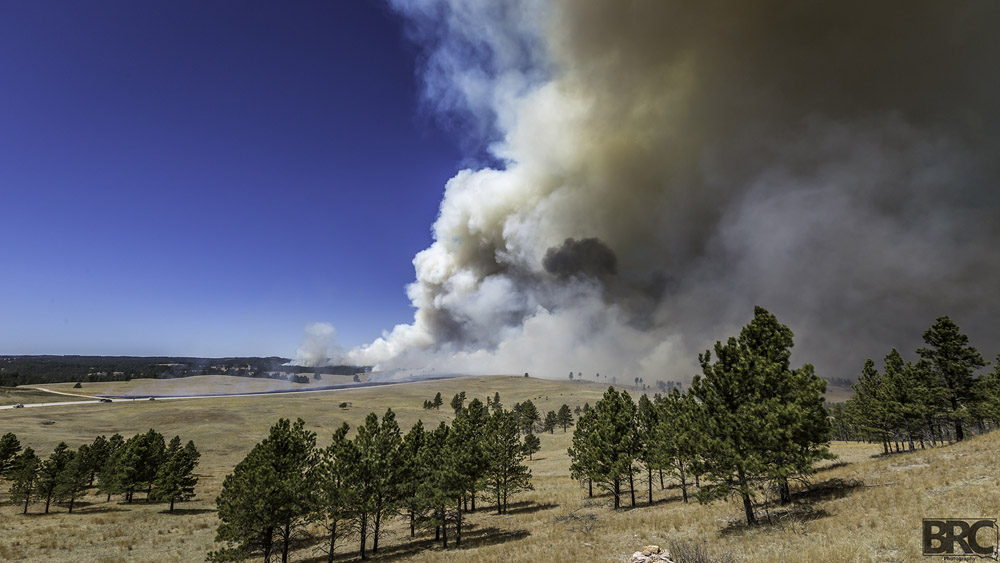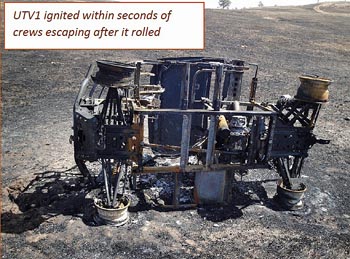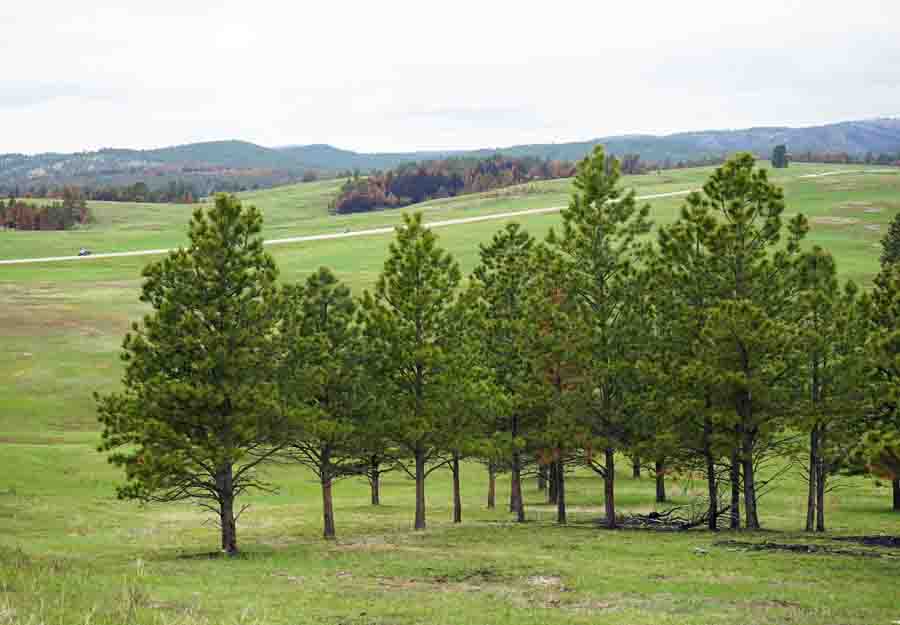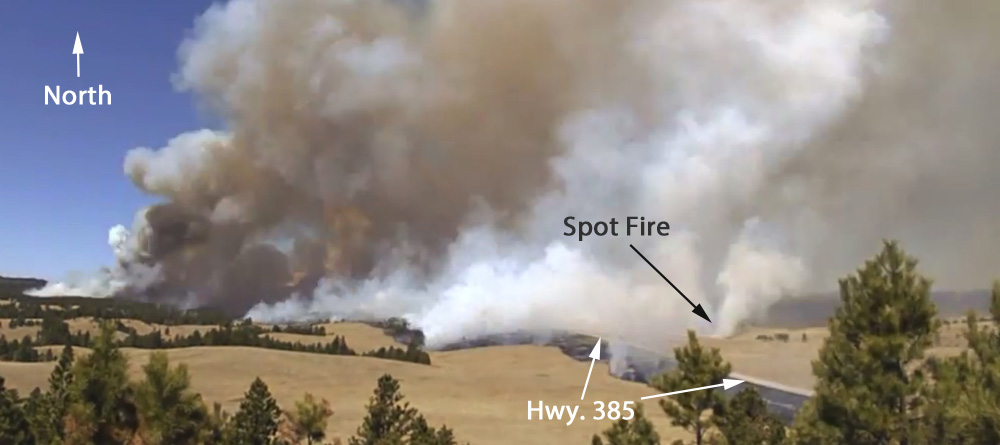
The National Park Service has released a “Facilitated Learning Analysis” (FLA) for the prescribed fire that escaped in Wind Cave National Park in the Black Hills of South Dakota April 13, 2015. The Cold Brook prescribed fire spotted almost 200 feet across U.S. Highway 385 burning an unplanned 5,420 acres beyond the 1,000 acres planned, all within the boundaries of the park. There were no injuries and no structures or private property burned. (In the interest of full disclosure, for five years the writer of this article was the Fire Management Officer for the NPS’ Northern Great Plains Fire Management Group which includes Wind Cave NP.)
 During the suppression action an all terrain vehicle with two people on board overturned. It was destroyed immediately by the approaching fire as the firefighters “jogged side-slope away from the fire until they had sufficient visibility to see their escape route safely into the black.” The line gear belonging to one of the two firefighters was consumed in the fire, since he did not have time to retrieve it from the tipped-over vehicle as the fire bore down.
During the suppression action an all terrain vehicle with two people on board overturned. It was destroyed immediately by the approaching fire as the firefighters “jogged side-slope away from the fire until they had sufficient visibility to see their escape route safely into the black.” The line gear belonging to one of the two firefighters was consumed in the fire, since he did not have time to retrieve it from the tipped-over vehicle as the fire bore down.
The 72-hour preliminary report on the incident stated that the FLA would be “due to the NPS Midwest Regional Director by May 29, 2015”. The report that was released through the Wildland Fire Lessons Learned Center is dated today.
The document, which you can download here (9 Mb), is long (62 pages of small font) and quite thorough. It delves deeply, very deeply, into the on site weather and long term weather records, as expected, and explores in detail the use of ATVs on prescribed burns and wildfires. In addition to discussion of the fire-related aspects of the analysis, the four writers, from the National Park Service, US Fish and Wildlife Service, and the US Forest Service, recommended that the “Technology and Development” program develop a wildland fire standard for equipment, configuration and performance of motorized off-highway vehicles.
The report includes a link to a time-lapse video, unlisted on YouTube, which I had not previously seen. Below is, first, a screen grab from the video, which we annotated, and after that the video itself. At 0:30, it goes by very quickly, but you can see the spot fire taking off.
It may just be the time compression of the video, but it appears that the ignition within a few hundred feet of the highway, including the patches of pines, was aggressive. A gust of wind that occurred as a patch of pines were burning intensely laid the smoke down close to the ground just before the spot fire became visible. The firefighters had expected that if there were spot fires on the east side, it would be short range and in grass, easily suppressed. In the video, it appears possible that burning embers could have been lofted from the patches of timber that burned intensely, rather than grass spotting into grass. Embers from heavy fuels and standing trees can travel much farther than from grass.
There are no earth-shaking revelations in the report. As is typical with FLAs, it has a long list of “notable successes”. Here are a few:
- No injuries.
- The fire remained within the park boundaries.
- No structures burned.
- Training and experience led to a smooth transition to suppression.
- In spite of the escape, they still completed the prescribed fire.
- Interagency involvement, response and support for both the prescribed and wildfire side of operations was quick and supportive with no delays.
- Knowing that a Red Flag Warning was in the forecast for the next day, they aggressively staffed the night shift in order to pick up the escape, knowing that if they failed it would be difficult to acquire adequate staffing for the next day. They stopped the spread that night, therefore large numbers of resources were not needed the next day.
A sampling of some of the issues identified in the report:
- There was pressure from the Chief of Resources in the Park to complete the burn that day.
- There was a perceived need to burn on the high end of the prescription in order to achieve the desired level of tree mortality.
- There were not enough firefighting resources on the east side of the burn when the escape occurred. More emphasis was placed on the south and west sides near the park boundary, areas with heavier fuels, where they figured escapes were more likely and would have serious consequences if they spread outside the park.
- Because of drought, fuels were abnormally dry.
- Before the project began, the Burn Plan was amended and approved, reducing the number of personnel required from 52 to 30. On the day of the burn 38 were assigned.
- Staffing levels in fire management at Wind Cave NP have suffered reductions, as has most of the NPS, but there has been no reduction in expectations for the accomplishment of prescribed fires in Wind Cave or the other seven parks the Fire Management Officer is responsible for.
- The Fire Management Officer reports to eight different park superintendents, all with different expectations, similar burn windows, and priorities for burning.
- The eight-foot high bison-proof fence on the western boundary of the park and the burn unit would have required that if firefighters were about to be entrapped by the fire or if there was a spot fire across it, they would have to scale the fence. The location of the fence, and the boundary on that side of the project, was not easy to defend.
- Some of the personnel interviewed for the report were disappointed that there was no After Action Review after the escaped fire.
- Everyone assigned to the incident was qualified for their positions, except for one person whose Work Capacity Test expired four days before the prescribed fire.
- The rollover of the ATV was the second one at the Park in three years. About 13 years ago another ATV caught fire on a prescribed fire in the Park and was destroyed, but did not roll over.
- ATV training does not include learning to operate the vehicle on the fireline.
- The Ag Pumps used on the ATVs on the incident had been switched out for Mini-strikers which do not provide enough power to be successful during aggressive suppression activities.
We have one criticism of the report, which is otherwise quite good. The maps are difficult to read. This is partially caused by the very dark background satellite image which does not add value but instead makes the maps, at least as they are represented in the .pdf document and viewed on a computer screen, almost useless. They might be more usable if printed, but who prints a 62-page report anymore? Unfortunately, maps are an integral part of documents like this.
One segment of the report that is interesting is that after acknowledging that risk is involved in prescribed fire, the authors wrote, “If you choose not to accept the risk of prescribed fire, then you may be transferring risk” to communities, the public, private lands, natural resources, or a situation that is significantly less manageable than the current situation such as a wildfire.
About four days after the incident South Dakota’s senior Senator, John Thune, sent a very strongly-worded letter to the Secretary of the Interior using phrases like “could easily have been prevented”, “jeopardizing lives and property”, “smoke will likely damage the lungs of young calves”, and demanding that reimbursement is made quickly to “private individuals, landowners, and local, county, and state entities who suffered economic losses”. Ready, Fire, Aim.
One of the conclusions identified in the report is:
The ignition of the prescribed fire was within the prescription parameters set forth in the prescribed fire plan, it was not ignited during a fire weather watch or warning and the burn was expected to be completed prior to the next day, April 14th.
The Senator also has introduced a bill that would require “collaboration with state government and local fire officials before a prescribed burn could be started on federal land when fire danger is at certain levels in the area of the prescribed burn”.
The report has an entire section, Appendix Five, titled “Interagency Communication and Comment”. Here is an excerpt:
Interagency support for the prescribed fire program at Wind Cave National Park is strong, and the lead interviewer stated she heard “a tremendous amount of support” in the interviews she conducted. It is of note that the Great Plains Interagency Dispatch Center was one of the first in the nation to fully support not only Federal agencies, but the state of South Dakota as well, beginning in 2003. Since the Center serves as the central ordering point all agencies, communication is streamlined, and resource availability is better known to all the partners.
It was apparent to all Team members that NPS staff has put a great deal of effort into the Interagency working relationships over the years and are considered professional partners.

Related articles on Wildfire Today:
—Cold Brook prescribed fire escapes in South Dakota (updated with post-fire photos)
—A UTV burned in the escaped prescribed fire in Wind Cave National Park
—Wind Cave National Park bounces back from escaped prescribed fire
—Comparison photos, 6 days and 39 days after escaped prescribed fire
—Senator criticizes Park Service over escaped prescribed fire
—Bill introduced to require local approval or collaboration of prescribed fires
—Articles on Wildfire Today tagged “escaped prescribed fire”
—Articles on Wildfire Today tagged “prescribed fire”

